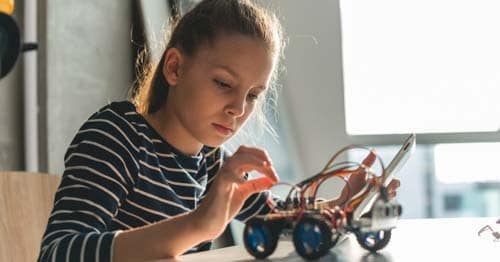Setting Healthy Screen Time Limits for Students Learning Online
by Julie Hersum
byCorissa Hennessey
5 min to readScience teachers know that metals are malleable. That is, that they can change in shape. Artists who work with clay know how malleable it is—shapeable, stretchable, and changeable. Likewise, cognitive scientists know that intelligence, or the ability to learn, is also malleable.
Now, decades of educational neuroscience research proves that when students become aware that their intelligence is malleable, their motivation to learn soars. But when they believe their intelligence or abilities are “fixed” by nature, their motivation may plummet at the first sign of a learning challenge.
Dr. Carol Dweck, a Stanford psychologist, researcher, and author, refers to these two very different outlooks on learning as the growth mindset and the fixed mindset. According to Dweck, these mindsets have a profound impact on students’ success—in the classroom and beyond.
If you have a fixed mindset, you believe that we are each born with fixed intelligence and abilities and that our personal efforts have relatively little impact on those abilities. However, if you possess a growth mindset, you believe that our intelligence and abilities can grow and improve over time through personal effort and perseverance.
In short, students benefit from knowing they can learn. Students with a growth mindset have higher self-esteem and more motivation to seek out challenges and learn from mistakes. They view a rigorous curriculum as an exciting and energizing challenge that can lead to success. They understand that just as people get stronger and more agile by training and working out physically, working out the brain can increase strength, agility, and, most importantly, learning potential.

Shifting to a Growth Mindsetour brains, thanks to malleable intelligence. Learning Coaches and teachers can play a major role in helping students shift from fixed mindsets to growth mindsets by modeling a growth mindset and teaching students study skills and strategies. This provides tools for solving problems and methods by which to face challenging content.
Adults can also enhance the learning process with positive, specific feedback. Rather than saying “you’re so smart,” praise the student’s process and strategies. Commenting on their intelligence as a form of praise can actually reinforce the idea that intelligence is fixed.
Rather than providing a generic “good job!” as students finish, Learning Coaches and teachers can integrate prompts and leading questions throughout lessons. According to Yes, Inc., here are some questions to ask that can encourage a growth mindset:

Intentional questions and activities encourage self-reflection, empowering students to analyze the way they learn. This kind of analysis helps learners recognize struggle as a positive part of ongoing growth rather than failure. Practice may not lead to perfection, but practice in the form of repetition can hone skills and enhance the potential for growth. Knowing that struggle is to be expected leads to increased effort and less discouragement as students work toward their goals.
The above techniques reinforce the learning process and reveal how you can grow your intelligence by developing a growth mindset. Learn more about how you can help your student grow and thrive through additional educational activities with Connections Academy.
